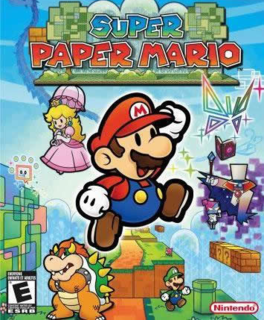If you ever stood at the side of your TV and wished you could see the world from Mario's eyes, this game is for you.
Super Paper Mario's audio is mostly great. Many of the songs are trippy re-imaginings of the old Mushroom Kingdom tunes, but the new ones also pay homage to the rudimentary sounds to be heard from the NES and Super Nintendo. Where it falters is in the annoying presence of the warning audio. Though these alarms do their job by pointing out the peril one occasionally puts himself through, they also are quite grating. I can be told my health is low without being given a headache. However the in-world sound effects are great, and the minimalistic voice-acting is exactly what the series (and this game specifically) demand. Their cartoonish nature complement's the game's whimsical visuals and gameplay excellently.
The game plays similar to the Mario Bros., Mario Land, and Mario World games of the 8- and 16-bit eras and has players holding their Wii remotes like NES controllers. The 2 button allows Mario to jump, and the player is invited to shake the Wii remote to earn bonus points (and thus level up faster), and the 1 button activates his equipped Pixl's ability. Throughout the game, you will find floating, neon sprites called Pixls, they aid Mario by lending their specific skill to him when called upon to do so. The Pixls cover most of the abilities Mario had in Paper Mario Thousand Year Door and the original Paper Mario, plus some interesting new ones. All are put to good use by the level design, but not all are needed to beat the game. And this reviewer has an inkling that he missed a Pixl or two himself.
Mario is also given the inventory standard in most role-playing games and many of the items found in previous Mario forays into the genre. These items do everything from heal our protagonist, to increase his stats, and some can be combined to make better items -- via cooking, a la the previous Paper Mario -- which aid Mario in amplified and compounded ways. Mario also soon gains the ability flip into 3D. The dimensional interplay lends itself to some mind-bending puzzles, and the graphics designers colour this strange arrangement in a suitable (because equally mind-bending) way. Each of the worlds has its own colourful style most of which have unique enemies and non-player characters to populate them. The use of parallax scrolling in this game not only makes for interesting puzzles, but also interesting visuals; As backgrounds will scroll independently of the foreground, and all will scroll independently of the camera. This gives each world the impression of a living diorama, an important element of the Paper Mario games. The game's visuals are full of the self-reflexivity for which Nintendo games are renowned. Such touches of flair will have varying degrees of appeal for different players who have varying degrees of experience with the Mario universe and accompanying lore, but everybody will snicker at the koopas in sunglasses, and most will pick up on the nods to the Mario games of their childhood.
On the subject of self-reflexivity, the game's dialogue and character illustration are the strength of the game's plot. Bowser will be filled with the melancholy of the pre-ordained role of final boss, helper characters will refer to "the great being from another dimension, who will know what the A button is", et cetera. Though the story's plot is that of a hackneyed love story, the way it plays out in the context of the Mario universe is captivating. Finally the idea of "pure evil" is brushed aside by a Mario game, but the idea of the internal split between a nemesis' true self and its source of evil (present in other Nintendo games) is manifest. In the end, Mario is the protagonist because he is who the player controls throughout most of the game, but he is not the main character in the classical sense of the word.
As a whole product, Super Paper Mario is easy to recommend to any Wii owner, and any fan of Nintendo's body of work. The game's unique visuals and gameplay are exactly the kinds of things Nintendo fans were worried their favourite studio would abandon when they announced their much-maligned Revolution.

